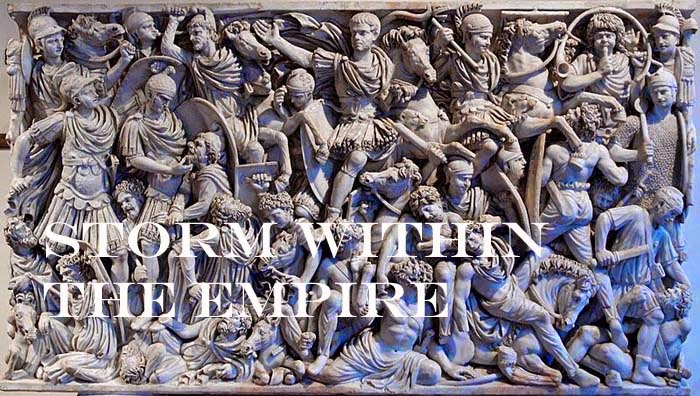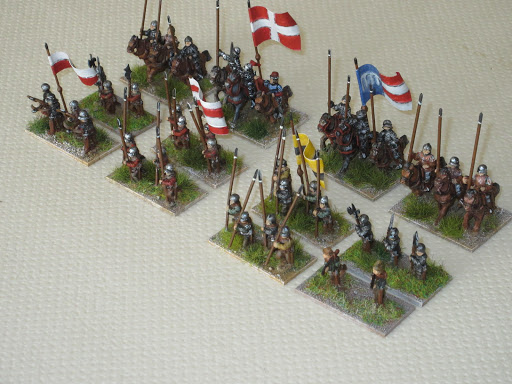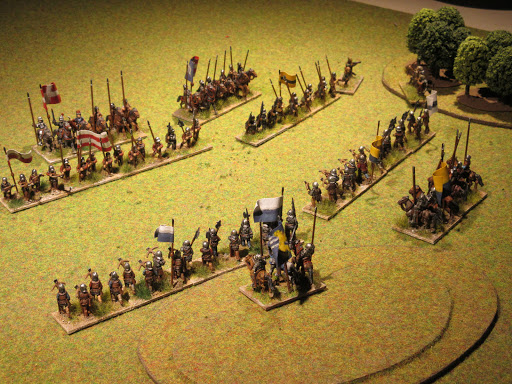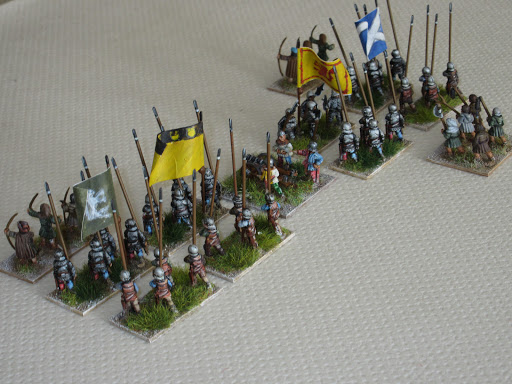To explore conflicts outside
the Italian peninsula I began with the Spanish invasion of Portugal. This will
be followed by a number of nations bordering the Baltic Sea, such as Poland,
Livonia, Lithuania, Muscovy. This should be interesting.
The Portuguese vs.
the Spanish
Fast and furious can best
describe the six matches. The Portuguese infantry are all classed as ‘fast’
(3Pk + 3Bd + Ps) which gave them an edge, whereas the Spanish were mindful of
their pike block of four elements. Both sides ended their tests scoring three
victories each.
Later Polish (IV/66) vs.
Livonia (Teutonic Order IV/30)
Wooded landscape did not
deter the Sword Brothers from trouncing the Polish in the opening game (4 – 2).
The Polish countered enveloping both Livonian flanks earning a 4 – 0 victory. Livonia
bounced back to winning game three, however, the best is yet to come. Bizarre
can best describe game four as the Polish Hetman fell in turn two. Most of the
Polish units were engaged leaving a column of Hungarian horse archers to fall
on an exposed Livonian flank initiating a chain reaction to include the death
of the Livonian Landmeister and the collapse of the entire army (5 – 2). The
town militia (8Cb) were exchanged for war waggons in the last two games. The
WWg earned their keep by supporting a third and fourth win for the Later Polish.
In retrospect all were great games.
Muscovy (IV/44b) vs.
Finland (Swedish list IV/54d)
The Swedes held an
advantageous position between two woods leaving only half their army exposed. Muscovy
failed to lure the Swedish out of their position and seeing their indecision
the Swedes moved their archers forward to disrupt their formation. Taking
advantage of the chaos, the Leidang closed on the Boyars to scatter the
Muscovites (4 – 1). The Muscovites came close to winning game three with well-coordinated
attacks by boyar and tartar horse archers, but this was not to be. The Muscovites
lost all six test games mainly to cavalry lines falling in disarray by archers
leaving surviving boyar to confront Leidang blade.
Tudor English (IV/83a)
vs. Scots Common (IV/16)
Like Flodden Field both
commanders dismounted, leaving the Border pickers the only mounted unit for
these tests. Simulating Landsknecht pike tactics, the Scots handily won the
opening test (5 – 1). However, a second win was not to be as the English blade
fell on an open flank of a pike column to tip the scales in their favour (4 –
3). In the following test, the Scots held favourable terrain however, it also
offered the English an opportunity to chip away at the pike blocks of the Scots
earning a 5 – 1 victory. Game four was long and tenacious, both commanders
locked in personal combat, however the deafening yells and shrill of Highland
bagpipes signalled the defeat of the English left flank earning the Scots another
victory (5 – 4). The next game is better described as a brawl than a battle,
the Scots won a narrow victory (4 – 3) again through the effort of the Highland
rabble. The final game was nearly a repeat of game four, long and tenacious
struggles with both sides incurring even losses. An unlucky pike column sealed
the fate of the Scots and England held the field with a 5 – 3 victory.

Summary
Of the three tests, the
army of Ivan the Mis-understood was disappointing. Their composition is not
unlike the early Byzantine which have proved successful in the past. Yet in
contrast, the Swedes, well supported by their archers, were not averse to
taking the battle to the Muscovites. The test games between the Scots and
English were a nice surprise. All games were close with the artillery of both
sides doing excellent work.
After the
completion of eight test matches of six games each there are not many more left
to do. Between matches, I had time to rebase a few figures to make sword and
buckler men, fast pikes and jinetes for the Spanish and Portuguese. After the
final test matches, I can determine which armies I would focus on. This will
mean some repainting to correct livery and of course adding flags.











